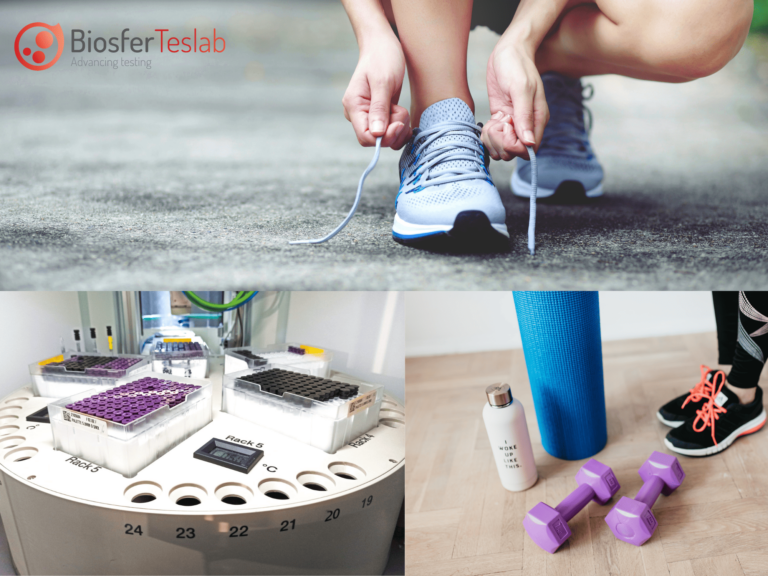Metabolomics has emerged in recent years as a powerful tool for the comprehensive assessment of biochemical changes occurring in the body during physical exercise. It is based on the analysis of metabolites, small molecules resulting from cellular processes, and offers an integrated view of the athlete’s physiology.
In the sports context, metabolomics enables a deep understanding of how exercise impacts metabolism. It opens new possibilities for personalizing training, nutrition, and recovery.
One of the most fascinating aspects of metabolomics is its ability to uncover metabolic changes associated with sports performance. During exercise, the body undergoes a series of adaptations to meet energy demands. Metabolomics allows the identification of profiles directly correlated with improved physical capacity, such as levels of lactate, fatty acids, and branched-chain amino acids (BCAAs).
For example, recent studies have identified that certain metabolites related to carbohydrate and fat metabolism can serve as biomarkers of aerobic performance. The early detection of these metabolites in athletes could enable adjustments to training programs to maximize efficient use of the body’s energy reserves.
Additionally, metabolomics helps understand how different types of exercise (endurance, strength, etc.) influence specific metabolic pathways, providing a solid foundation for designing personalized training based on the athlete’s metabolic profile.
Injury prevention is one of the main challenges in sports medicine. In this context, metabolomics has proven to be a valuable tool by enabling the early identification of biomarkers related to injury risk. A key example is the use of Glyc-A, an emerging biomarker reflecting chronic systemic inflammation levels in the body.
Glyc-A is an integrated signal obtained through nuclear magnetic resonance (NMR) that measures the glycosylation of various acute-phase proteins, such as alpha-1-antitrypsin, haptoglobin, and orosomucoid. These proteins elevate in response to inflammation. Quantifying Glyc-A offers a more stable and reproducible picture of the inflammatory state than traditional markers like C-reactive protein (CRP).
In sports, low-grade inflammation over prolonged periods can contribute to overuse injuries, such as tendinopathies or chronic muscle fatigue. Measuring Glyc-A allows detection of subclinical inflammatory states that might go unnoticed until an injury manifests.
An athlete with elevated Glyc-A levels might be at risk of developing an injury due to chronic low-grade inflammation, even if no obvious symptoms are present. By identifying this metabolic alteration early, sports physicians could adjust the training load or implement anti-inflammatory strategies (such as diet modification or supplementation) to reduce injury risk.
Regular Glyc-A monitoring in athletes provides ongoing insight into their inflammatory state, enabling proactive adjustments in training programs to minimize accumulated damage. This is particularly valuable in high-impact sports or during intense training phases, where the body is under constant stress, and the balance between recovery and inflammation is crucial to avoid injuries.
The inclusion of biomarkers like Glyc-A in athletes’ regular evaluations represents a significant advance in preventive sports medicine, helping detect and mitigate potential risk factors before injuries occur.
Recovery is one of the most studied aspects of metabolomics applied to sports. After intense competition or training, the body needs to restore its metabolic balance. Through metabolite analysis, it is possible to monitor fatigue levels, hydration status, and inflammation.
Measuring blood lactate is a common practice in endurance sports to assess recovery levels. However, metabolomics provides a more detailed approach, measuring other biomarkers related to muscle stress and cellular damage.
This approach helps nutritionists optimize post-exercise nutrition by adjusting macronutrient and supplement intake according to the athlete’s individual needs. This way, recovery can be accelerated, and the risk of injuries related to fatigue or poor muscle recovery minimized.
One of the most promising advances in sports metabolomics is its potential to personalize nutrition according to each athlete’s metabolic profile. Since people respond differently to food intake, metabolomics allows for precise adjustments to diets and supplements.
Some athletes may metabolize carbohydrates more efficiently, while others might benefit more from a high-fat diet. By analyzing metabolites that reflect fat oxidation capacity or glucose utilization, it is possible to design nutritional plans tailored to each athlete’s specific metabolic needs.
This perspective not only optimizes performance during training and competition but also helps prevent nutritional deficiencies that could compromise long-term health
One of the main challenges in implementing metabolomics in sports is the standardization of sampling, analysis, and interpretation protocols for metabolomic data. However, at Biosfer Teslab, we have developed a standardized workflow based on nuclear magnetic resonance (NMR), which has proven robust and stable for over 10 years in the biomedical field. This work has been validated in studies related to cardiovascular and metabolic health, and we firmly believe its application can extend to the sports sector.
The technology we use is versatile, allowing us to analyze metabolic profiles accurately and reproducibly. We are convinced that this capability could be harnessed to optimize performance, recovery, and injury prevention in athletes. This NMR standardization could offer an effective solution to overcome current barriers in the field of sports metabolomics, opening new opportunities for personalized training and sports nutrition.
At Biosfer Teslab, we invite researchers, physicians, and sports professionals to explore metabolomics as a key tool for advancing scientific knowledge and leveraging its full potential in sports practice.
The field of sports metabolomics is full of opportunities waiting to be explored. We believe that collaboration between different disciplines can lead to significant discoveries benefiting both athletes and sports medicine as a whole.
